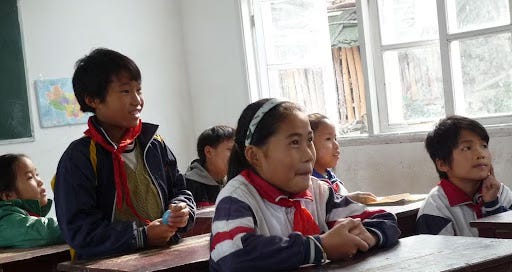Imagine growing up where seeing your parents is a rare event, perhaps only during the holidays—if you’re fortunate. For nearly one in five children in China, this is their everyday reality. These children, known as left-behind children (LBC), stay in rural villages while their parents migrate to cities in search of better job opportunities. As China undergoes rapid urbanization and industrialization, millions of rural laborers have flocked to urban centers, seeking higher wages and improved living conditions. However, this mass migration often leaves behind a generation of children and elderly grandparents in rural areas, creating a web of educational, emotional, and social challenges that deeply affect those left in the countryside.
At the heart of this issue lies China’s rigid hukou system, or household registration. Under this system, individuals are registered as residents of a specific area, and access to public services such as healthcare and education is tied to their registration location. For migrant workers, moving to a city without transferring their hukou makes them ineligible for essential services, a restriction that extends to their children. As a result, many parents face the heart-wrenching decision of leaving their children behind, believing that life in rural areas, under the care of grandparents or relatives, is preferable to the uncertain and often deprived existence they would endure in the city.
In 2020, an estimated 69 million children in China were considered left-behind, a staggering figure comparable to the number of children in the United States. Recognizing the gravity of the situation, the Chinese government has introduced various policies aimed at protecting these children. Guidelines have been established to ensure that local authorities monitor guardianship arrangements, as it is illegal for minors to live alone. Schools and hospitals are now expected to report suspected cases of abuse, and efforts have been made to reduce the overall number of left-behind children. In spite of these measures, significant gaps remain in addressing the core issues faced by these children, especially regarding education, mental health, and gender inequality.
The Education Gap: Infrastructure Without Resources
The Chinese government’s efforts to address the plight of left-behind children have largely focused on improving the physical infrastructure of rural schools. New buildings, modern computer labs, and advanced projection devices have been introduced in many village schools, giving the appearance of progress. However, the deeper issue of inadequate educational resources has been largely overlooked. The absence of quality educational “software”—in the form of skilled teachers, updated curricula, and learning materials—has rendered these technological advancements ineffective.
For example, while schools may be equipped with brand-new computers, they often lack the proper training and software to make these tools useful. Additionally, teachers in these schools are typically recent college graduates, many of whom view their rural teaching positions as temporary stepping stones. High turnover rates among young teachers disrupt the learning environment, preventing students from developing stable relationships with their teachers or receiving consistent, high-quality instruction.
Moreover, left-behind children often find themselves at a disadvantage when preparing for China’s national college entrance exam, the gaokao. Like the SAT in the U.S., the gaokao is seen as a test that can open doors to prestigious institutions and better job prospects, but it is far more critical, regarded as a life-defining moment. Scoring well can significantly improve one’s social mobility, while poor performance can severely restrict future opportunities. While the government has introduced policies to provide these students with additional points on the gaokao to compensate for their educational disadvantages, the reality is that many are still ill-prepared for the rigorous demands of higher education. With limited access to top-tier teachers, advanced study materials, and academic mentorship, left-behind children are often unable to compete with their urban counterparts, perpetuating a cycle of educational inequality.
The Emotional Toll: Mental Health and Abuse
Beyond academic challenges, left-behind children grapple with profound mental health issues stemming from prolonged separation from their parents. Studies show that LBC with one or both parents away experience rates of depression 13.1% and 16.1% higher respectively, compared to their peers . However, depression is just one aspect of their emotional struggles. LBC are prone to a range of psychological issues, including feelings of insecurity, loneliness, anger, low self-esteem, helplessness, and diminished life satisfaction. These emotional hardships significantly increase the risk of social withdrawal and suicide attempts, with alarming statistics revealing that around 34% of LBC have suicidal tendencies, and 9% have tragically taken their own lives.
The psychological toll of parental absence is compounded by deep-seated feelings of neglect, isolation, and abandonment. In rural areas, where mental health resources are scarce, left-behind children have little access to professional support, forcing many to endure their struggles in silence. Without proper intervention, these emotional wounds often go untreated, leading to long-term consequences. Anxiety, chronic depression, and difficulty forming healthy relationships later in life are just some of the devastating effects that can follow, perpetuating a cycle of emotional trauma across generations.
Government policies aimed at addressing the mental health of left-behind children remain inadequate. While hospitals and schools have been instructed to report cases of abuse, the underlying issues that contribute to these children’s vulnerability—namely, their isolation and lack of parental presence—have not been adequately addressed. More comprehensive mental health interventions, including counseling services and emotional support programs, are urgently needed to mitigate the lasting harm caused by parental separation.
Gender Inequality: Daughters Left Behind
Another particularly troubling dimension of the left-behind children crisis is the stark gender disparity in who is left behind. Studies reveal that parents migrating to cities with hukou restrictions are 9% more likely to leave their daughters behind, especially as they transition into middle school. Daughters are most often left without either parent present, a pattern not seen with sons. At this critical age, boys are less likely to experience the same abandonment. The study also highlights differences in parental remittance behavior, showing that migrant parents who leave daughters behind send 10% less money than those who leave sons. As a result, girls receive less parental time and financial support compared to boys. This gender-based inequality reflects deeply ingrained cultural preferences for sons and economic considerations, perpetuating unequal treatment between boys and girls in rural China.
First, hukou restrictions exacerbate pre-existing son preference in rural Chinese families. Migrant parents often face significant financial strain due to the high cost of living in cities, and many prioritize the education of their sons over their daughters. Sons are traditionally viewed as the primary caretakers of aging parents, making them a more valuable investment in the eyes of many families. Consequently, parents may send their daughters back to rural areas to save money while investing more in their sons’ education and future prospects.
Second, the perceived economic return on investment in education is often lower for females than for males. In a labor market where men are seen as more productive and capable of earning higher wages, parents may make the pragmatic decision to focus their resources on their sons. This dynamic reinforces existing gender inequalities and limits the opportunities available to girls, perpetuating cycles of poverty and marginalization.
Finally, traditional cultural expectations surrounding gender roles continue to shape the decisions of many rural families. Sons are expected to work in cities and support their parents in old age, while daughters are more likely to remain in rural areas, taking on caregiving roles. These deeply entrenched gender norms further limit the prospects of left-behind girls, reinforcing their role as secondary to their brothers in both education and familial expectations.
Conclusion: Addressing the Overlooked Challenges
While the Chinese government has made efforts to address the issue of left-behind children, significant gaps remain in its approach. The lack of educational resources, the mental health crisis, and the gender disparities that disproportionately affect girls are critical issues that have not been adequately addressed. To ensure a brighter future for these children, the government must take a more holistic approach—one that not only improves physical infrastructure but also invests in the long-term emotional, educational, and social well-being of left-behind children.
Addressing these challenges requires more than policy reforms. It necessitates a cultural shift that recognizes the value of every child, regardless of gender or location, and provides them with the resources and support they need to thrive. Only then can China’s left-behind children have a chance at overcoming the obstacles that have been placed in their way and building a future filled with hope and opportunity.







Great article! I am currently reading a historical fiction novel that similarly comments on the plight of rural China.
Fantastic work! This article was extremely interesting to read.